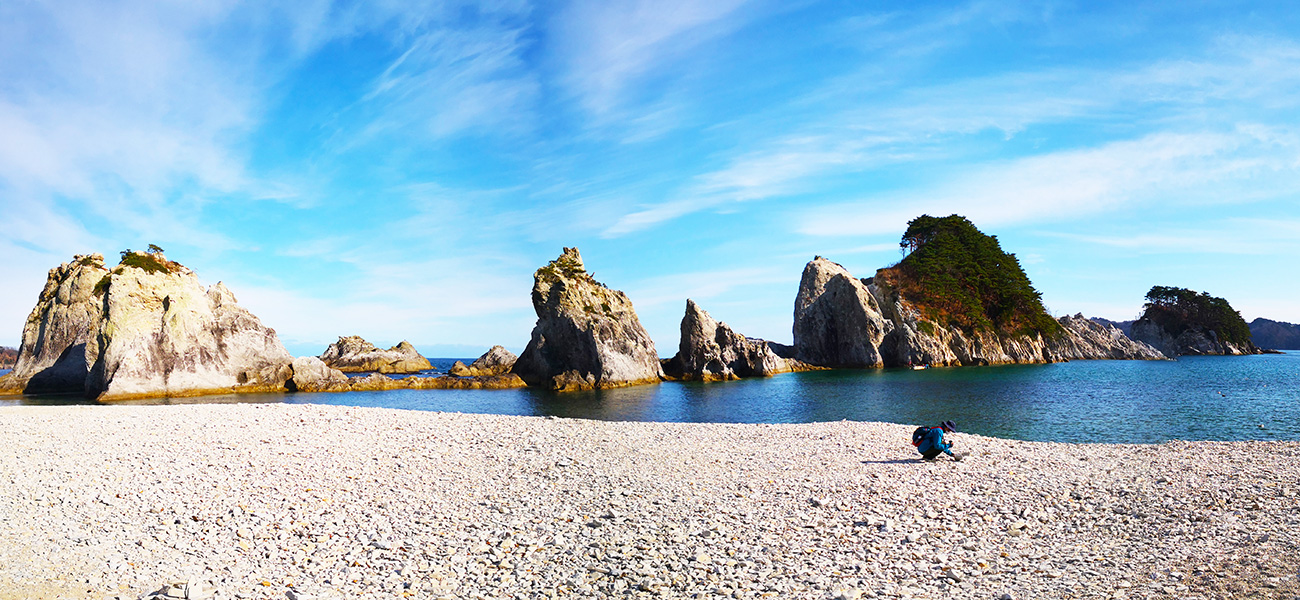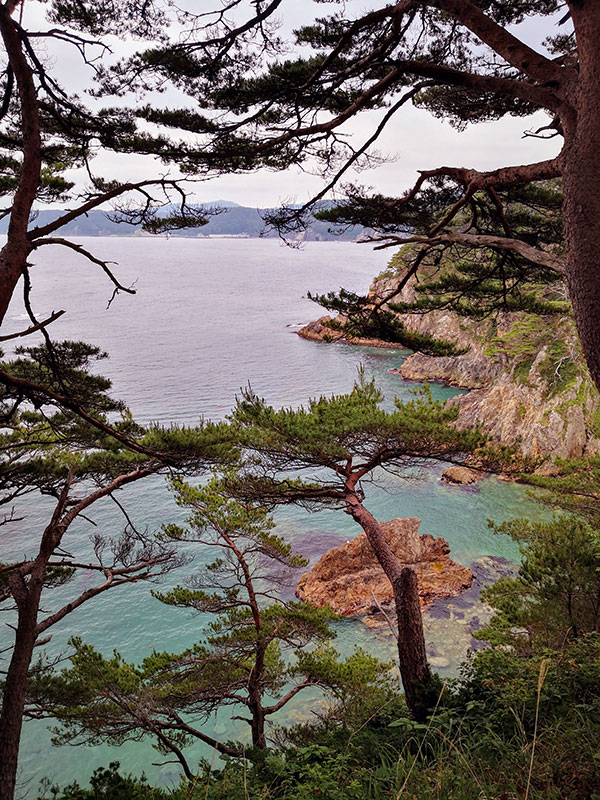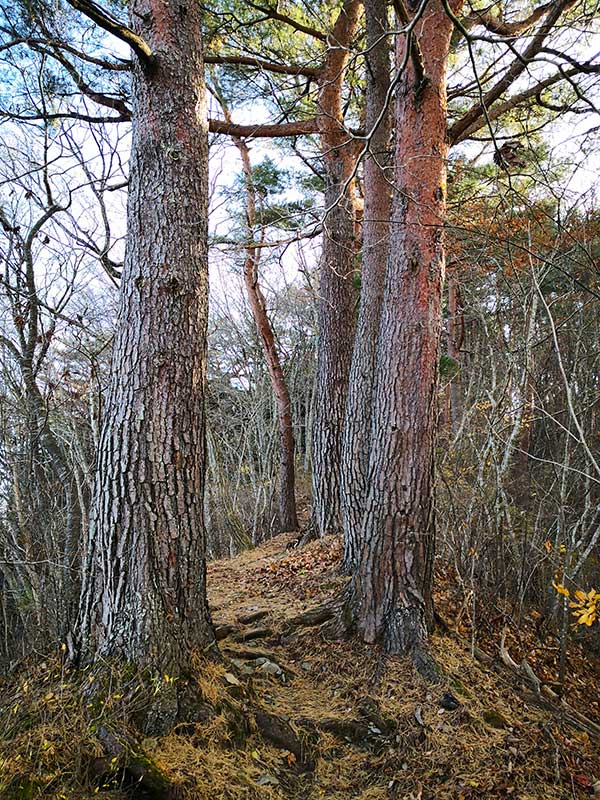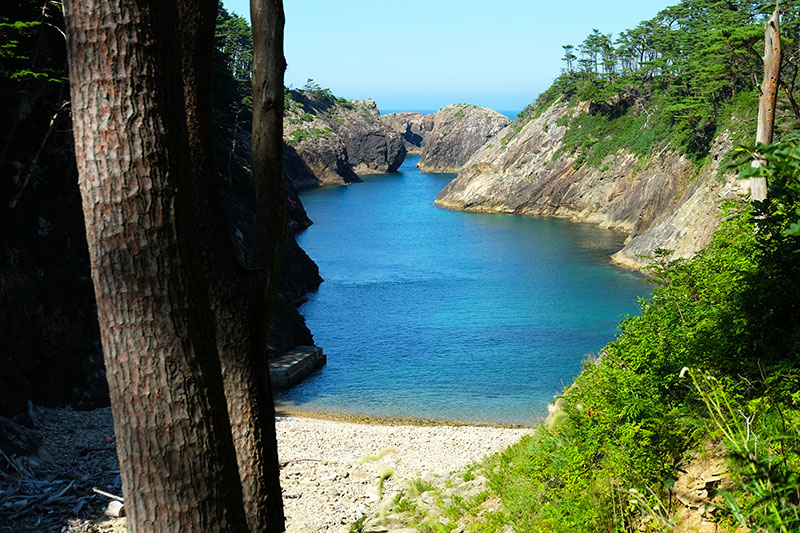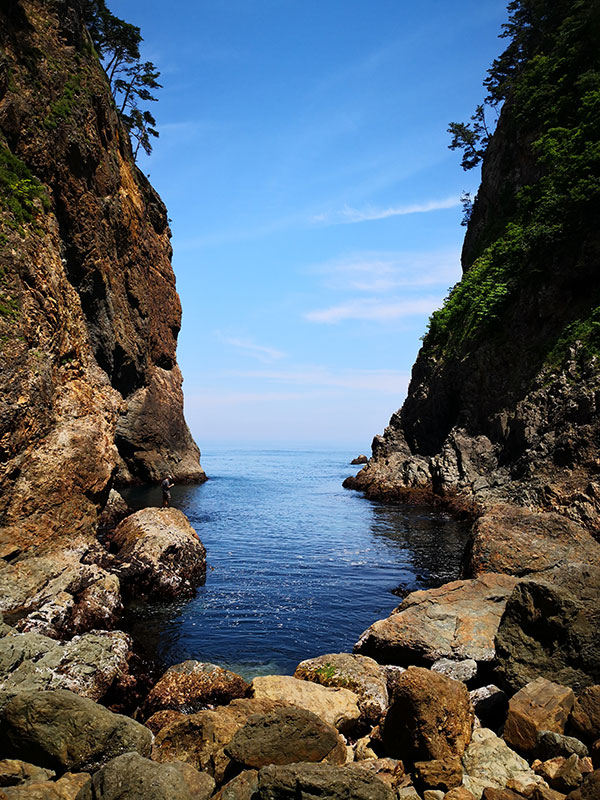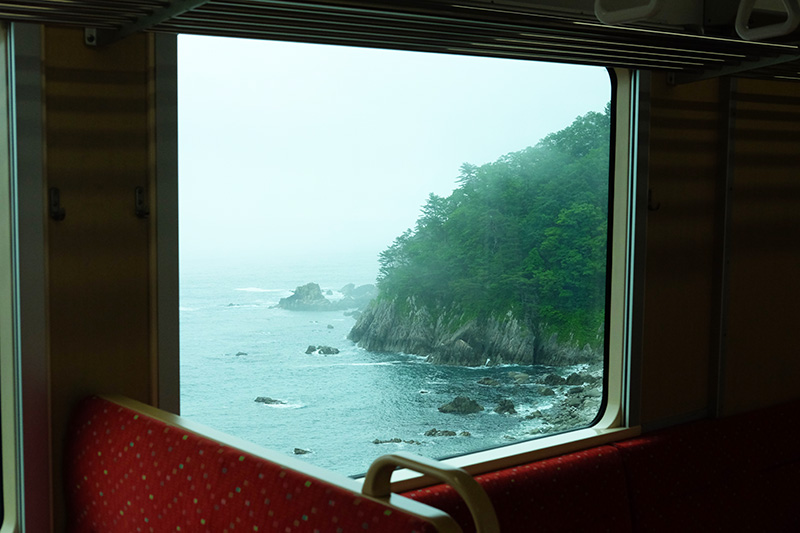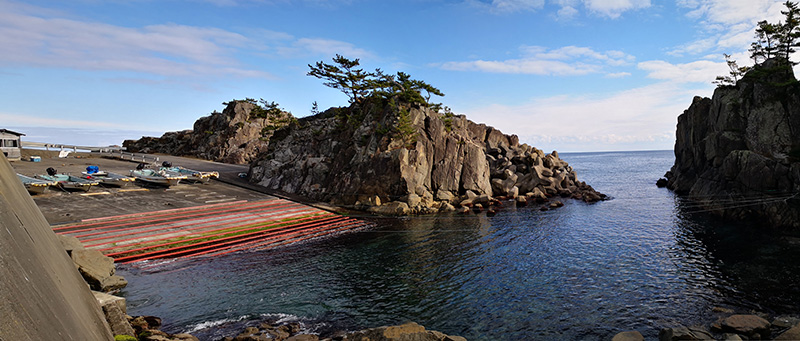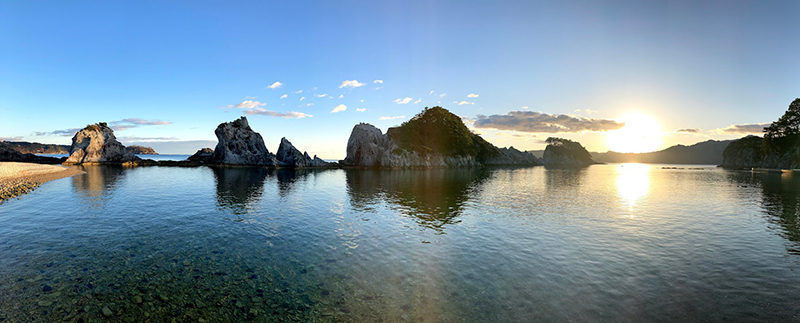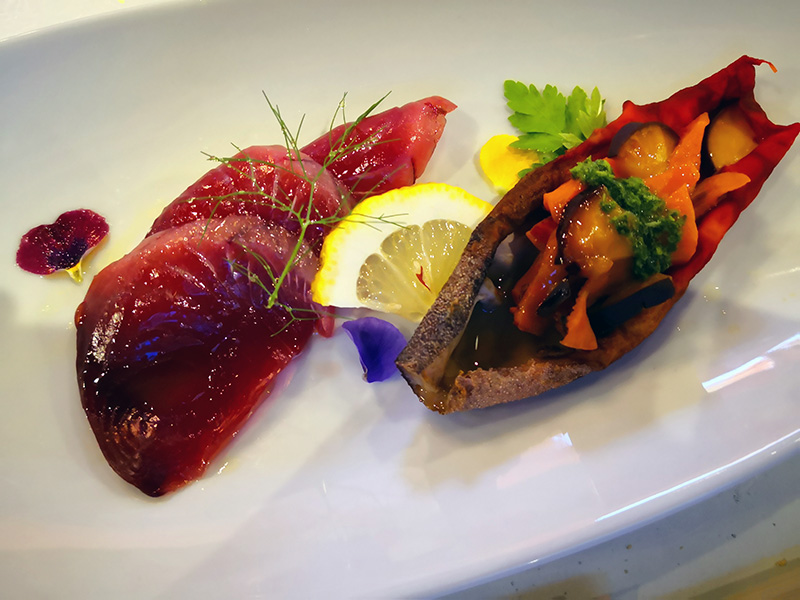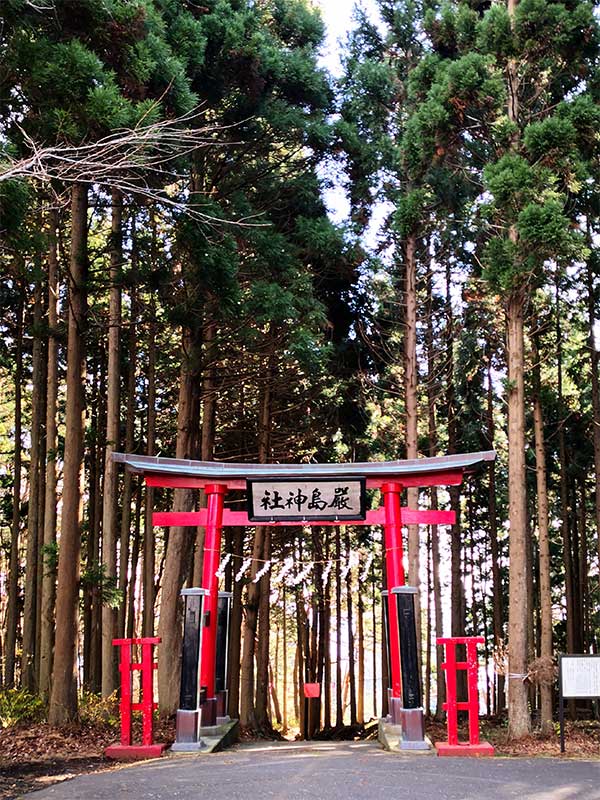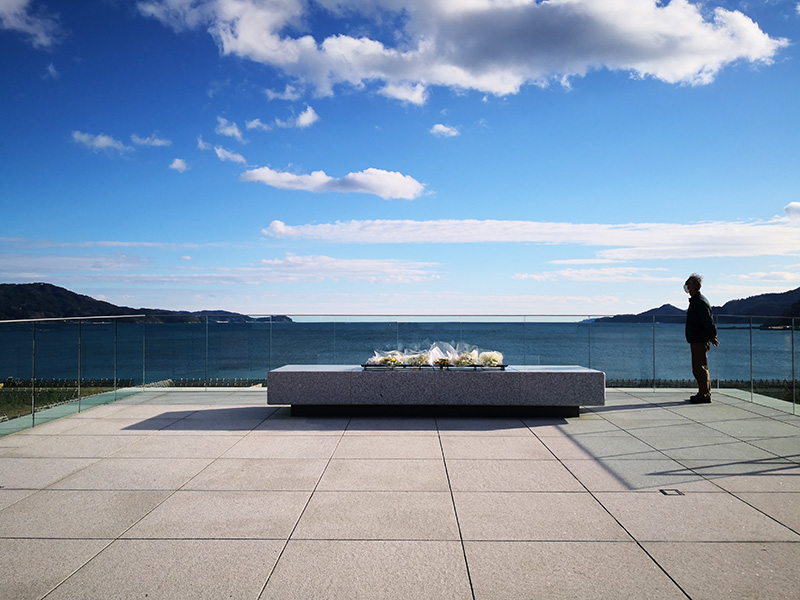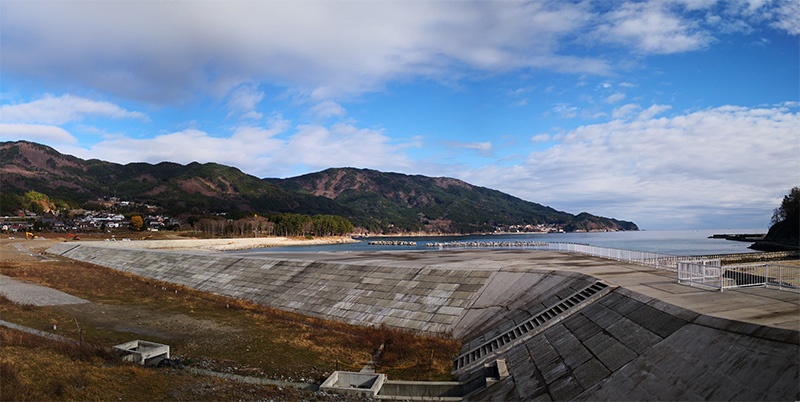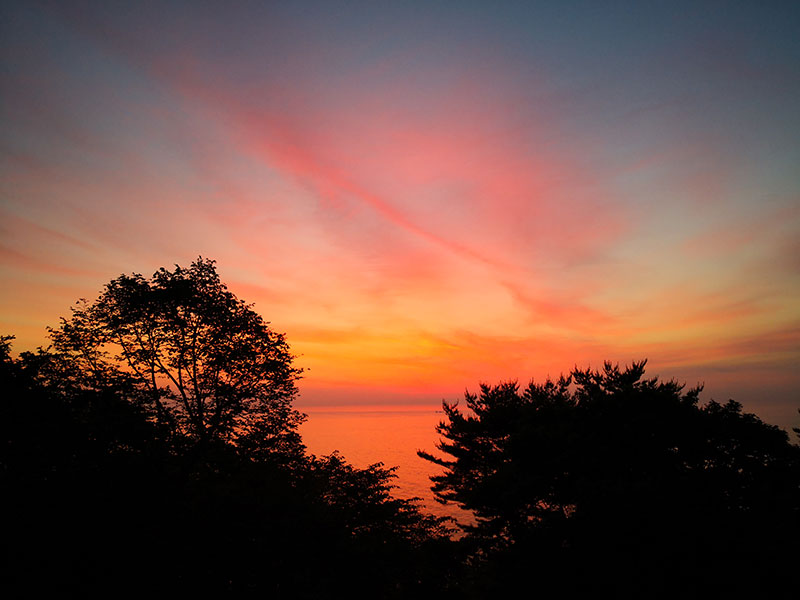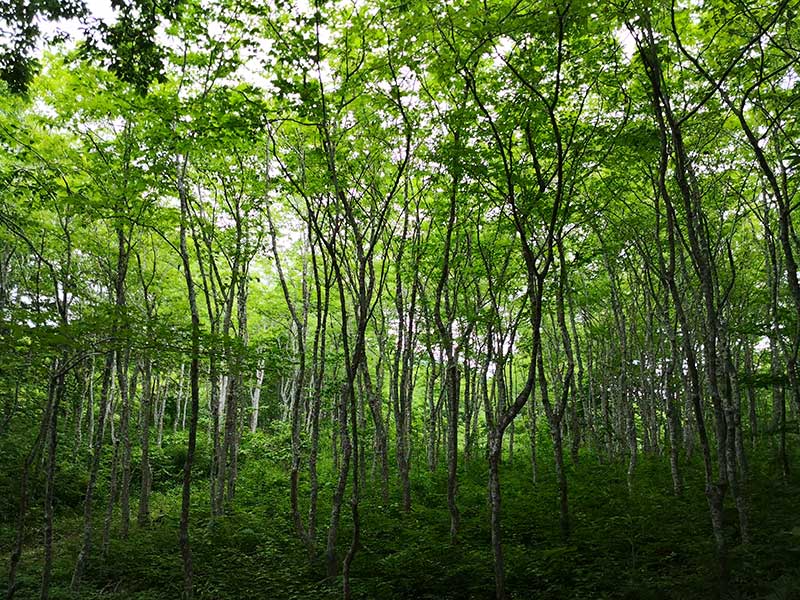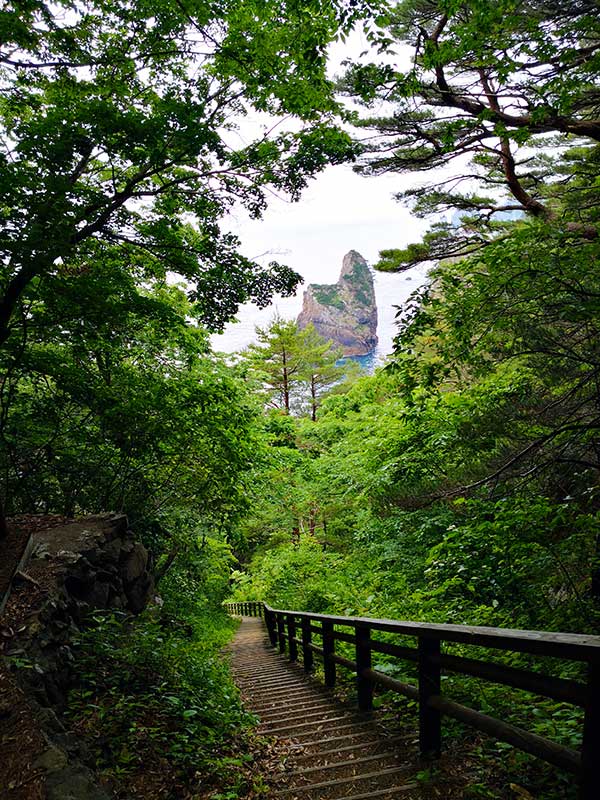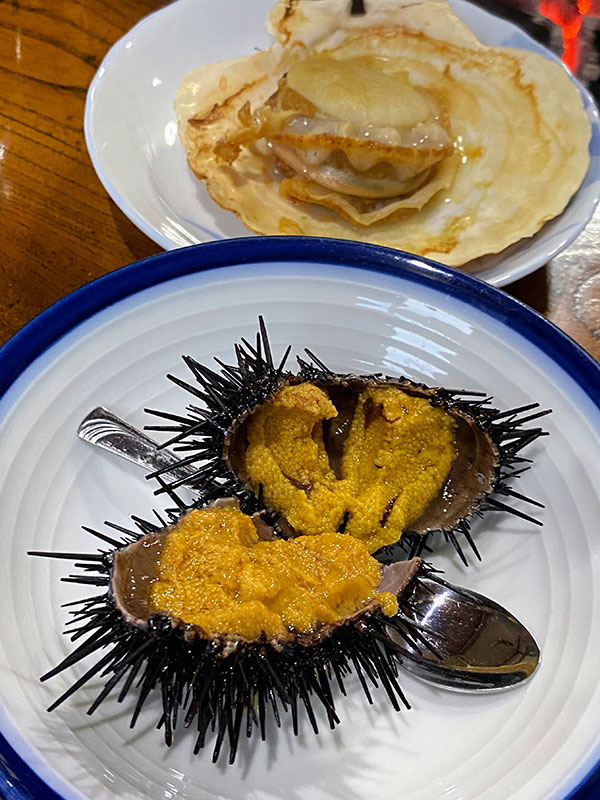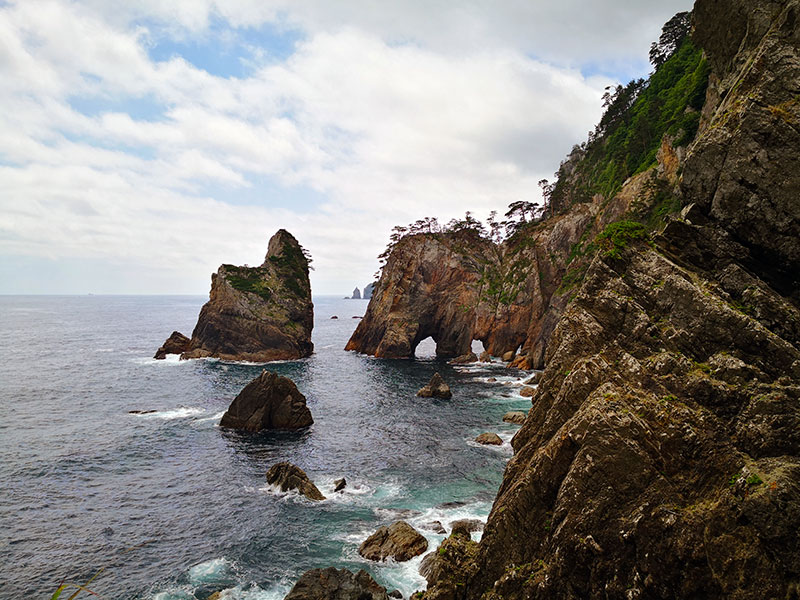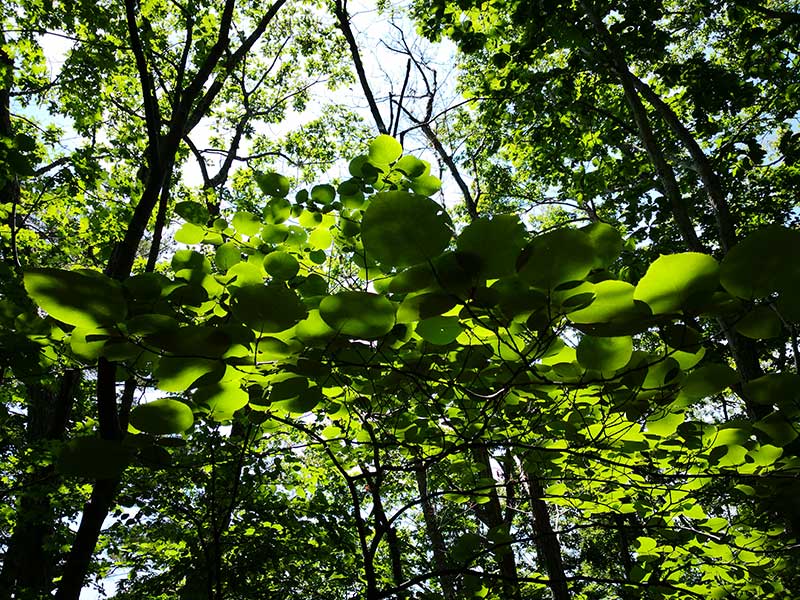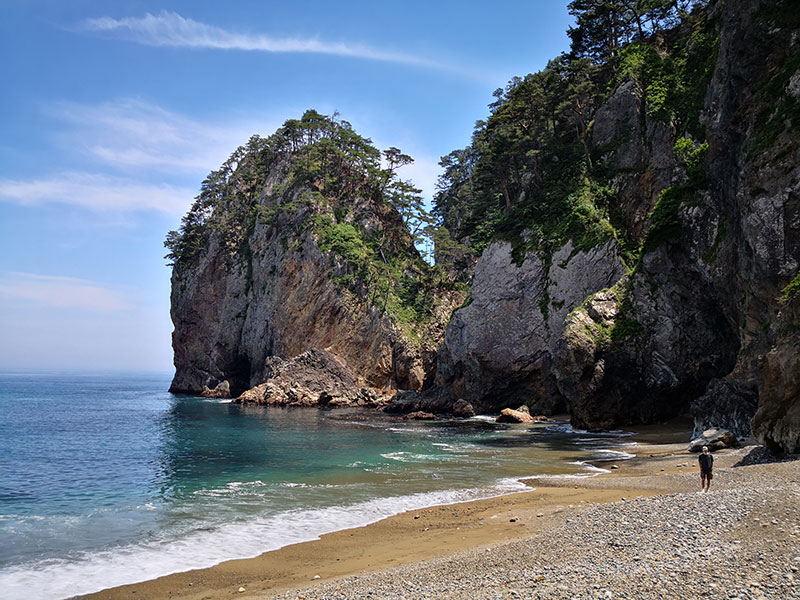A walking tour following a spectacular and varied coastal trail in northern Japan.
A guided exploration following the Michinoku Coastal Trail in Japan’s Tohoku region; excellent walks from beaches to cliff tops and through coastal communities. Spectacular views over the Pacific Ocean and intricately carved coastline. Beautifully located accommodation mostly overlooking the sea, bountiful seafood cuisine.
April to June, and September to November.
A 9-day, 8-night tour starting in Hachinohe and finishing in Kesennuma. Accommodation is in hotels and Japanese inns. Please read more on accommodation here. The maximum group size for this tour is 12 persons. We have no minimum size. If we accept a booking we guarantee to run the tour.
Walk Japan’s Michinoku Coastal Trail tour explores the Sanriku Coast on the eastern side of Japan’s northern Tohoku region by following sections of the Michinoku Shiokaze Coastal Trail, a footpath connecting Aomori, Iwate, Miyagi and Fukushima Prefectures. Tohoku is by equal measures beautiful and rugged, and often remote. It is also bountiful, especially aside the ocean, which at times can be very harsh. This area took the full force of the earthquake and then tsunami, which swept over many of the coastal communities here in March 2011.
Our journey leads us over grassy promenades, through forests, along remote beaches and soaring clifftops, and to fishing ports, some tiny with a few one-man boats and others with fleets of ocean-going trawlers. We visit many quiet coastal villages and towns, some untouched by the dramatic events of 2011 and others where the work of reconstruction still continues. Throughout this region the qualities of resilience, persistence, generosity, sense of community and kindness commonly found in Japan are abundantly clear, and wherever we go on our travels we are warmly welcomed by the locals into their midst.
The Michinoku Shiokaze Coastal Trail, a long-distance footpath that weaves its way aside the Pacific Ocean for 1,025 kilometres (637 miles), was established as a symbol of recovery and to encourage others to visit and enjoy this wonderful region. The Trail’s officially stated objectives include the enjoyment of beautiful sights and natural landscapes; to welcome all who love to walk and bring about connections between locals and visitors; and to memorialise the kindness and harshness of nature including the events of 2011.
Our journey begins in Hachinohe, a pleasant regional city and the Michinoku Shiokaze Coastal Trail’s most northerly point. From hereon, we travel south following the trail aside the clear emerald-blue Pacific Ocean, on foot and sometimes by charming one or two-carriage local trains. At times the coast is bounded by soaring precipices, at other times it is an intricate carving of inlets and bays. All the communities we visit are watched over by ancient Shinto shrines built to give thanks for bounty found in the surrounding fertile seas and as a redoubt against its occasional overwhelming powerful nature. On our way we visit some of the most picturesque natural sights in Japan including classic pine tree coastlines and Jodogahama, a beautifully formed cliff of white sandstone framed by emerald seas. With luck we may occasionally catch sight of ospreys soaring high above us or an elusive serow, a goat-antelope like animal. As we travel south the geography becomes less remote and the population greater but the welcome no less warm. We end the tour in Kesennuma, from where trains depart to other destinations in Japan.
The seas off the Sanriku Coast include some of the richest fishing grounds found anywhere in the world and seafood is a significant part of the local diet; so much so that we cannot recommend the Michinoku Coastal Trail tour to anyone who does not care for it. For fish-lovers, however, it is a paradise and we enjoy some of the freshest available. Depending on the season our meals include a wide variety of local seafood such as abalone, oysters, clams, salmon, and squid. The majority of our accommodation is aside the ocean and incorporate baths overlooking the sea for a delightful and leisurely way to relax before our culinary feasts each evening. Good weather willing, early risers can watch glorious sunrises over the Pacific Ocean while enjoying a reviving morning soak.

At the end of the tour, please note that the travel time by train to both airports can take up to five and a half hours.
On some days of the following itinerary we may have to alter our walking route according to the timing of high tide.
Day 1 Hachinohe
The tour starts at 6pm in Hachinohe, a pleasant regional city conveniently connected to Tokyo by Shinkansen bullet trains. Your Walk Japan Tour Leader welcomes everyone in the lobby of the tour hotel, which is in the city’s lively Hon-Hachinohe district, at 6pm. The tour briefing starts here and continues over dinner at a nearby restaurant, which is a popular haunt of the locals.
Accommodation: Western-style hotel.
Meals: Dinner provided.
Total walking: N/A.
Total elevation gain: N/A.
Day 2 Hachinohe - Tanesashi Coast
An early morning start but before departing we send our main baggage ahead by courier, as we will do on many days of the tour, to our accommodation for this evening. We board a local train to the outskirts of the city on a short journey to Kabushima, an impressive Shinto shrine standing atop a promontory overlooking the sea. Venerating Benzaiten, a kami Shinto god that protects fishermen and brings business success, Kabushima is popular with locals and also with flocks of black-tailed gulls, which nest here during summer months.
Kabushima Shrine is the official northern start point of the 1,025km-long Michinoku Shiokaze Coastal Trail and marks the beginning of our exploration of this impressive coastal walking route. We set out south over terrain today that is either flat or gently undulating and provides us with a comfortable day’s walking to start our tour together. The trail threads its way over wide grassy expanses and sandy beaches and we enjoy a picnic lunch en route. Finally, we reach our accommodation, a small inn just inland of the coast. Our friendly hostess serves us a dinner of delicious homely fishermen’s fare.
Accommodation: Guesthouse.
Meals: Breakfast, lunch & dinner provided.
Total walking: 10.5km (6.5 miles).
Total elevation gain: 40m (131ft).
Day 3 Tanesashi Coast - Samurai-hama - Kuji
After breakfast a private-hire vehicle ride whisks us to the start of our walk today, which leads us through some of the remotest countryside of the tour. Our trail passes through forest and from time to time leads us to the rocky coast. Along the way we come across Samurai-ishi, an expanse of giant rock slabs on which, in rough seas, waves crash spectacularly. Adjacent is a tiny picturesque fishing port.
The trail continues on, largely through broad leaf and pine coastal forests, where we eat an alfresco lunch in a beautiful setting with views over the ocean. We continue on to a quiet hamlet, where our walk ends at a small Shinto shrine set on a high promontory. From here we are afforded spectacular views back to the coast we negotiated today and over the surrounding seas. A private-hire vehicle transfers us to nearby Kuji and our accommodation, a hotel in the centre of this town. We venture out to a delightful restaurant to dine on local seafood delicacies.
Accommodation: Western-style hotel.
Meals: Breakfast, lunch & dinner provided.
Total walking: 11km (6.9 miles).
Total elevation gain: 378m (1,240ft).
Day 4 Kuji - Kitayama-zaki - Tanohata
A private-hire vehicle takes us to Fudai, a large coastal village that is dominated by a huge 15.5m high seawall and flood gates. These were completed in 1984 and, although topped in part by the tsunami in 2011, held firm and saved Fudai from serious inundation.
An initial steep climb brings us to the top of high sheer cliffs, part of a dynamic coastline we explore over today and tomorrow. Our path threads its way through forests that from time-to-time open up to give us expansive views over vast blue seas. We mostly follow the cliff top but also find ourselves steeply descending into a ravine. From here we criss-cross a stream over some rockier terrain before ascending the cliffs following a forest trail. The day ends at Kitayama-zaki, a popular scenic spot where we can relax with ice-cream and coffee.
Accommodation: Japanese-style hotel.
Meals: Breakfast, lunch & dinner provided.
Total walking: 10.5km (6.5 miles).
Total elevation gain: 655m (2,149ft).
Day 5 Tanohata - Kitayama-zaki - Tanohata
After breakfast, we return to the point where we completed yesterday’s walk along this beautiful coastline to continue on the trail back to our inn. Today provides us with more spectacular walking and is also the biggest test of our mettle.
We quickly descend down steep steps to a cove before climbing again to the cliff tops. Thereafter follow a series of steep ascents and descents that provide us with a good workout and fantastic views. In places hand-hewn tunnels connect remote beaches and occasionally we have to use short ladders to scale some heights. Finally, we reach a clutch of picturesque fisherman’s huts, which have all been reconstructed after being washed away in 2011. We relax here before completing the last stretch of walking back to our hotel, where we repeat the bathing and gastronomic pleasures of the previous evening.
Accommodation: Japanese-style hotel.
Meals: Breakfast, lunch & dinner provided.
Total walking: 10km (6.2 miles).
Total elevation gain: 750m (2,460ft).
Day 6 Tanohata - Jodogahama
After breakfast we transfer by train, this time on the Sanriku Railway. Severely damaged in 2011, the struggle to fully restore this railway line in 2019 has been a poignant symbol, felt throughout Japan, of the resilience, fortitude and faith in the future found in the Tohoku region. We alight at a remote unmanned station.
Today’s trail follows a particularly geologically interesting coastline that includes amongst some great views a blowhole. Here, in heavy seas, compressed water spouts out to a height of 30 metres. Today’s walking is easier than yesterday but include descents and ascents over steep steps. From hereon, we also begin to see more of the scars wrought by the 2011 tsunami and the heavy construction undertaken since to help alleviate future inundations.
After lunch, another picnic, we follow more scenic trails and finish our day at Jodogahama, a beautifully photogenic spot. A series of heavily weathered cliffs, quiet bays and sparklingly white sandy beaches, all topped off with red pines, provides us with a quintessential Japanese scene. Our accommodation tonight is adjacent, allowing us to enjoy Jodogahama at our leisure throughout the evening and early the following day. Bathing precedes another delicious Japanese banquet for dinner.
Accommodation: Onsen hot spring resort.
Meals: Breakfast, lunch & dinner provided.
Total walking: 8km (5 miles).
Total elevation gain: 358m (1,175ft).
Day 7 Jodogahama - Kuwadai Pass - Ofunato
Given suitable weather, sunrises are a feature of this tour, but perhaps the one at Jodogahama is the most impressive as the sun appears over the surrounding cliffs. An event well worth rising for in the early morning.
We drive through Miyako to its railway station to re-board a Sanriku train. The height of the newly constructed seawalls, which we pass on our way into Miyako, is a clear testament to the power of the sea in ferment and also to the indefatigable nature of the locals. We see similar scenes several times as we travel further south on our journey.
Today, we are leaving behind the remoter rocky coastline of northern Tohoku we have experienced since leaving Hachinohe. Beyond Miyako the coast changes to an intricate scenic web of peninsulas and bays which shelter calmer seas. Over the centuries many port towns and villages developed along this coast to take advantage of the rich fishing grounds found offshore.
Our walk today is a section of the Hama-kaido, an old trail that used to be the main thoroughfare between Sendai, Tohoku’s principal city, and the coast. In the Edo Period (1603-1868), Sendai was the seat of the powerful Date samurai clan and products such as salt, iron and, of course, seafood were transported along this route.
After a steep switch-back climb through forests to 400m above sea level we reach the Kuwadai Pass. We enjoy a picnic lunch here before descending to Yoshihama, a village set on high ground above the sea. Learning the harsh lessons from a tsunami in 1896 the locals moved their village out of harm’s way, very much to their descendants’ appreciation in 2011.
A private-hire vehicle takes us to Ofunato, one of Japan’s major fishing ports, and to a modern Japanese inn, where we spend the evening. After relaxing in the accommodation’s onsen hot spring baths we are treated to another sumptuous evening meal.
Accommodation: Modern Japanese inn with onsen hot spring baths.
Meals: Breakfast, lunch & dinner provided.
Total walking: 11km (6.9 miles).
Total elevation gain: 637m (2,090ft).
Day 8 Ofunato - Rikuzentakata - Kesennuma
Our walk today is along another stretch of the Hama-kaido, which together with our previous day’s walking has been incorporated into the Michinoku Shiokaze Coastal Trail. We begin at a local carpenter’s workshop. This region has been known in Japan since the early Edo Period (1603-1868) for its peripatetic Kesen-daiku carpenters expert in the building of intricate temples and shrines around the nation. These include the grand Meiji Jingu shrine in Tokyo. Just beyond we stop at a series of increasingly larger waterfalls set in an atmospheric narrow gorge. Torii shrine gates line the gorge, which along with the waterfalls is revered locally as a site sacred to Shinto. A number of these were made at the workshop where we began our walk.
The waterfalls marks the start of our ascent, which is similar to yesterday's, to the Ryori Pass. Our descent leads us back to Ofunato from where we transfer by vehicle to Kesennuma and our hotel for the evening. En route we pass through Rikuzentakata, where we visit Fumon-ji, a temple and prime example of the skilled work of Kesen-daiku carpenters. Within this beautifully serene complex is an exquisitely carved three-storied pagoda.
Next, we visit an understated but beautifully rendered memorial to those lost locally in the 2011 tsunami. In equal measures it is sombre, educational and a marketplace for local produce and gifts - a symbol of the Japanese forthright and positive attitude to life’s ups and downs.
Our accommodation, which is either a modern hotel or an inn depending on availability, is in the centre of Kesennuma, another major fishing port. Tonight, after refreshing ourselves, we venture into town for dinner in one of Kesennuma’s top restaurants.
Accommodation: Traditional Japanese inn.
Meals: Breakfast, lunch & dinner provided.
Total walking: 9km (5.5 miles).
Total elevation gain: 547m (1,795ft).
Day 9 Kesennuma
The tour finishes after breakfast in our accommodation. Transfers to the local railway station for onward journey are made by hotel bus or taxi. The Walk Japan Tour Leader is available to help with your ticketing arrangements.
Accommodation: N/A.
Meals: Breakfast provided.
Total walking: N/A.
Total elevation gain: N/A.
This itinerary is subject to change.
The airport closest to the tour start point is Aomori Airport (AOJ). However, the journey from here to Hachinohe on public transport involves a number of interchanges and can take up to three hours. The journey is more easily made by train from either of Tokyo’s Narita or Haneda International Airports.
-----
FROM TOKYO’S HANEDA AIRPORT (HND)
Tokyo Monorail trains depart for and terminate at Hamamatsu Station. Transfer here to the trains on either the JR Yamanote or JR Keihin-Tohoku Lines for Tokyo Station. To Hachinohe from Tokyo Station please see the section below.
-----
FROM TOKYO’S NARITA AIRPORT (NRT)
JR Narita Express (NEX) trains depart every 30 minutes for Tokyo Station. To Hachinohe from Tokyo Station please see the section below.
-----
FROM TOKYO STATION
The journey to Hachinohe is made on the JR Tohoku-Hokkaido Shinkansen, one of the super-fast bullet train lines. Departures are every hour and the journey is approximately 3 hours. From Hachinohe, take the Hachinohe JR line for a short journey to Hon-Hachinohe, from where it is a ten-minute walk to the accommodation.
The pre-tour pack includes detailed instructions, including a map, for travel to the accommodation at the start of the tour.
Please note that travel by train from Kesennuma to Narita Airport via Tokyo Station takes approximately 5.5 hours and to Haneda Airport approximately 4.5 hours.

